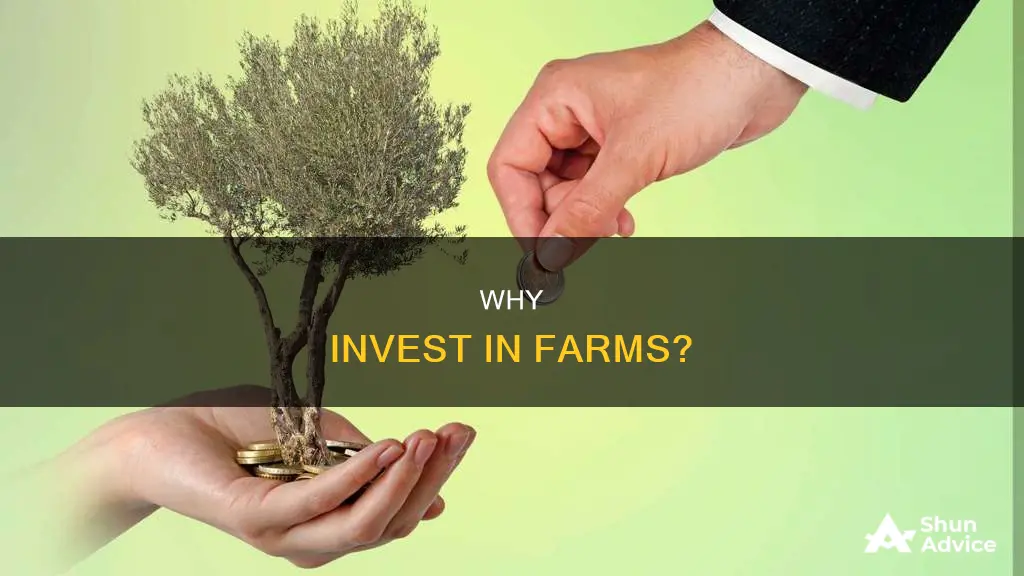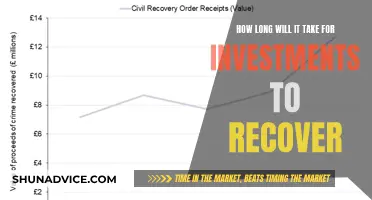
Investing in farms is an attractive prospect for many. With food demand expected to increase by up to 98% by 2050, agricultural markets will be changing dramatically. Farms across the globe will need to increase crop production by expanding the amount of farmland being utilised and by enhancing productivity on existing land.
There are several ways to invest in farms. One can buy a farm and manage it, lease it to farmers, or partner with an operating farmer. Alternatively, one can invest in farmland real estate investment trusts (REITs), which are corporate entities that own, operate, or finance income-producing agricultural real estate. Another option is to use online syndication and crowdfunding platforms, which act as digital marketplaces showcasing a range of farmland projects that need funding. Finally, one can invest in agricultural stocks or farmland mutual funds and ETFs.
There are benefits and drawbacks to investing in farms. On the one hand, farmland often acts as a hedge against inflation and has a low correlation to traditional assets. On the other hand, investing in farms can be illiquid, and there are environmental and regulatory risks to consider.
What You'll Learn

Farmland as a long-term investment
Investing in farmland is a long-term commitment that can provide stable returns and help diversify your portfolio. With the world's population projected to reach over 10 billion by 2050, food demand is expected to increase by up to 98%. This means farmers will need to enhance productivity and expand their farmland to meet the growing demand. As a result, farmland becomes an attractive investment opportunity, as it is a finite resource that is crucial for global food production.
Additionally, the average age of farmers in the US is 58, and as more farmers reach retirement age, a significant portion of farmland will change hands, creating investment opportunities.
Benefits of Investing in Farmland
- Stable Investment: Farmland values have historically increased over time, with American farmland values rising by about 6.1% per year over the last 50 years, according to the USDA. This makes it a more stable investment compared to the stock market.
- Recession-Resilient: Agriculture is often considered recession-proof because food is a necessity, and people will still need to eat during economic downturns.
- Hedge Against Inflation: Farmland values are linked to agricultural commodity prices, which tend to rise during inflationary periods.
- Long-Term Returns: Farmland investments are long-term commitments that can provide returns over several years or even decades.
- Social and Economic Impact: Investing in farmland keeps farmers in business, supports local communities, and ensures global food security.
- Tax Benefits: There are various tax advantages associated with agricultural investments, such as depreciation benefits, conservation trusts, and favourable property tax rates.
Types of Farmland Investments
- Buy and Manage Farmland: This option provides the opportunity for direct ownership and management of farmland. However, it requires significant upfront costs, long hours, and a diverse set of skills.
- Private Equity Funds: These funds pool investor money to purchase farmland and lease it to farmers, providing returns through appreciation and lease rates.
- REITs (Real Estate Investment Trusts): REITs offer liquidity and lower initial investment requirements, but they may have lower returns and limit your control over the investment.
- Crowdfunding: Agriculture crowdfunding allows investors to buy fractional equity in farmland with a minimal upfront investment, providing control over the geographical area and commodity type.
Risks and Considerations
When investing in farmland, it's important to consider the following:
- Long-Term Commitment: Farmland investments are long-term, and returns may take 12 months to 7 years or more to materialize.
- Illiquidity: Farmland is a relatively illiquid asset, and selling it quickly may be challenging.
- Environmental Risks: Droughts, floods, pests, and diseases can impact crop yields and profitability.
- Regulatory Risks: Changes in environmental regulations, water rights issues, and other legislative measures can affect operations and returns.
- Soil Fertility and Water Availability: These are crucial factors when investing in farmland, as they directly impact crop yields and the success of the investment.
- Organic vs. Conventional Farming: Not all soil types and locations are suitable for organic farming, and converting conventional farmland to organic farming requires careful analysis.
Dogecoin: Worthy Investment or Just a Meme?
You may want to see also

Farmland as a hedge against inflation
When it comes to investing, financial advisors often recommend taking a slow and steady approach and diversifying your portfolio. This is especially important during periods of economic instability when market activity is unpredictable.
One asset class that is often overlooked is agriculture, and more specifically, farmland. Farmland has a number of advantages as an investment, including its ability to act as a hedge against inflation.
Firstly, everyone needs to eat, and the ongoing need for food means that farmland will always be in demand. This gives it a stable foundation as an investment. In addition, the price of farmland is closely correlated with the Consumer Price Index (CPI), with research showing a 70% correlation. This means that as inflation rises, so too does the value of farmland.
Another factor to consider is the limited supply of arable land. The United States lost 11 million acres of arable farmland over the past two decades, and it is predicted that the total amount of arable land worldwide will decrease by 250 million acres by 2050. As the supply of farmland decreases, its value as an asset increases, creating a natural hedge against inflation.
Farmland also has the advantage of generating operating income. Unlike real estate, which has fixed pricing, the income generated by farmland can fluctuate based on economic conditions. This means that during inflationary periods, when the cost of producing crops increases, commodity prices also rise, resulting in higher revenue for farmers and a boost in the value of the land.
Historically, gold has been the most common hedge against inflation. However, farmland has several advantages over gold as an investment. Firstly, farmland produces a positive cash flow, whereas gold does not. Secondly, farmland is expected to outperform gold in the coming decades due to its limited supply and the increasing demand for food.
In summary, farmland is an attractive investment option because it offers stable returns, low volatility, and a hedge against inflation. By investing in farmland, investors can protect their portfolios from the negative effects of inflation and benefit from the increasing value of a scarce resource.
Investing in Others: A Worthy Bet
You may want to see also

Farmland investments offer high returns
Investing in farmland has become an increasingly attractive prospect for investors. While farmers and ranchers own about 61% of the land they use, non-farming investors own a small slice of America's farmland, which has been growing as investors acquire productive farmland for their portfolios.
Long History of Solid Returns
Over the last 50 years, the value of American farmland has risen by about 6.1% per year, with only five down years. Since 1991, it has produced a positive return every year, generating an average annual return of 11.5%, outperforming almost all other asset classes.
Inflation-Resistant
Farmland is a real asset that produces commodities like corn and grain. As such, it benefits from inflation, which would boost not only acreage values but also crop income.
Low Volatility
Farmland returns have historically had less volatility than most other asset classes, including the 10-year U.S. Treasury Bond, S&P 500, gold, and Dow Jones REIT Index.
Recession-Proof
Many investors consider agriculture to be recession-proof because food is a universal necessity. As the world's population increases, farming will play an increasingly important role in sustaining global societies.
Uncorrelated with Other Asset Classes
The inclusion of farmland in a portfolio increases diversification as its returns have historically been uncorrelated with conventional assets and securities such as stocks, bonds, real estate, and even short-term agricultural commodity prices.
Superior Risk-Adjusted Returns
Farmland has outperformed most major assets, including commercial real estate, for over 30 years. It has also been a good hedge against inflation.
Long-Term Tailwinds
Farmland has high demand and a decreasing supply. With the world population expected to reach 9.7 billion by 2050, approximately 70% more food will be required than is consumed today. With increasing food production needs and decreasing land suitable for cultivation, this will create a supply-demand imbalance.
Shark Tank: Payback Time?
You may want to see also

Tax benefits of investing in farmland
Investing in farmland can be a great business move for both farmers and investors, offering excellent tax advantages. Here are some of the tax benefits of investing in farmland:
Property Tax Benefits
All 50 states in the US offer favourable property tax rates for agricultural land. This is to help farmers retain their farms in the face of urban expansion. While the criteria for eligibility vary across states, most determine eligibility based on the size of the farm and its income. These favourable rates can significantly lower the tax burden on the land.
Conservation Trusts
Farmers can place their land in conservation trusts through conservation easements. These trusts aim to preserve natural areas, including farmland, ranchland, water sources, and cultural resources or landmarks. When a portion or all of the farmland is placed in a conservation trust, the land remains privately owned, but future development is prevented. This also applies to future owners of the land. Conservation easements offer tax advantages, such as qualifying as a charitable tax deduction on the donor's federal income tax return if it benefits the public.
Depreciation Benefits
While the cost of the farmland itself cannot be depreciated because land does not wear out or become obsolete, certain crops, such as fruit and nut trees, can qualify for tax depreciation benefits due to their limited production cycle. Additionally, farm buildings, livestock pens, and other farm equipment can be depreciated over time, and these expenses can be deducted from gross income.
Sales or Property Tax Exemptions
States may offer exemptions from sales, use, or property taxes for farms. This could mean avoiding these taxes altogether or receiving credits for taxes paid after filing tax returns.
Bonus Depreciation
Bonus depreciation is a tax incentive that allows investors to accelerate the depreciation of certain qualifying capital investments or expenditures. For farmland, this can include mature trees, vines, farm buildings, equipment, irrigation systems, and capitalized development costs. This incentive can help reduce taxable income for a specific tax year.
1031 Exchanges
Farmland is eligible for 1031 exchanges, which allow investors to reinvest the sale proceeds of an existing investment property into a similar real property interest, enabling tax savings at the time of sale. This can help investors defer recognition of certain capital gains and depreciation recapture liabilities.
Self-Directed Individual Retirement Accounts (SDIRAs)
Investing in farmland through an SDIRA blends the attractive returns of farmland with the tax benefits of retirement accounts. SDIRAs provide investors with the flexibility to diversify their portfolios beyond traditional assets and into alternative investments, such as farmland.
China's Bubble: Global Investment Risk
You may want to see also

Farmland REITs
- They provide farmers with access to capital by acquiring land and other agricultural real estate and then leasing it back to them under long-term leases.
- They give investors access to farmland as an asset class, allowing them to receive regular dividend payments.
Benefits of Farmland REITs
- Diversification: Farmland REITs offer investors uncorrelated returns compared to other asset classes like stocks, bonds, and cryptocurrencies, helping to reduce portfolio volatility.
- Inflation Hedge: Historically, farmland has been a better hedge against inflation than stocks, bonds, and gold. There is a strong correlation between farmland values and the consumer price index.
- Attractive Returns: Farmland provides investors with rental income and capital appreciation, resulting in attractive total returns. From 1992 to 2021, the combined average annual return was 11%.
- Liquidity: Farmland REITs are publicly traded, making them highly liquid and easily accessible for investors.
- Low Entry Point: Farmland REITs have low transaction and administrative costs compared to direct acquisitions, allowing investors to acquire a small number of shares on public exchanges instead of purchasing entire properties.
Risks of Farmland REITs
- Interest Rate Risk: Rising interest rates make it more expensive for REITs to borrow money, impacting their ability to make acquisitions.
- Natural Disasters: Events like droughts, wildfires, and insect infestations can affect crop yields and the ability of farmer-tenants to pay rent.
- Crop Prices: Volatile crop prices, especially for annual commodity crops, can affect farm income and the ability of tenants to make rental payments.
- Tenant Risk: Farming is a challenging business due to natural disasters, equipment costs, labour costs, and other issues. If farmer-tenants encounter financial difficulties, they may default on rental payments.
- Tax Implications: REITs have significant tax implications, including property taxes, which can impact shareholder returns. REIT income is also taxed as ordinary income rather than investment dividends.
Examples of Farmland REITs
- Gladstone Land (NASDAQ: LAND): Focuses on fruit and produce farms, with holdings in 14-15 states. Offers monthly dividends.
- Farmland Partners Inc. (NYSE: FPI): Diversified across 16-20 states and over 25 crop types. Offers quarterly dividends.
Fisher Investments: Happy Customers?
You may want to see also
Frequently asked questions
An investment farm is an agricultural business operation that is purchased and operated for financial gain. The intention of investing in a farm may be to generate a profit or to create a tax deduction for the owner.
People invest in farms because they believe that agriculture and farming investments are recession-proof. As the world's population increases, farming will play an increasingly important role in sustaining global societies.
There are several ways to invest in farms, including purchasing an existing farm, leasing it to a farmer, or converting non-agricultural land into a farm. People can also invest in farms indirectly by investing in agricultural stocks, mutual funds, or exchange-traded funds (ETFs).
Some risks associated with investing in farms include drought, fire, pests, and disease, which could damage crops. Regulatory changes and environmental factors can also impact the profitability of farm investments.
Investing in farms can provide stable returns and act as a hedge against inflation. Farmland values have historically risen over time, and farming can provide social and economic benefits to communities.







